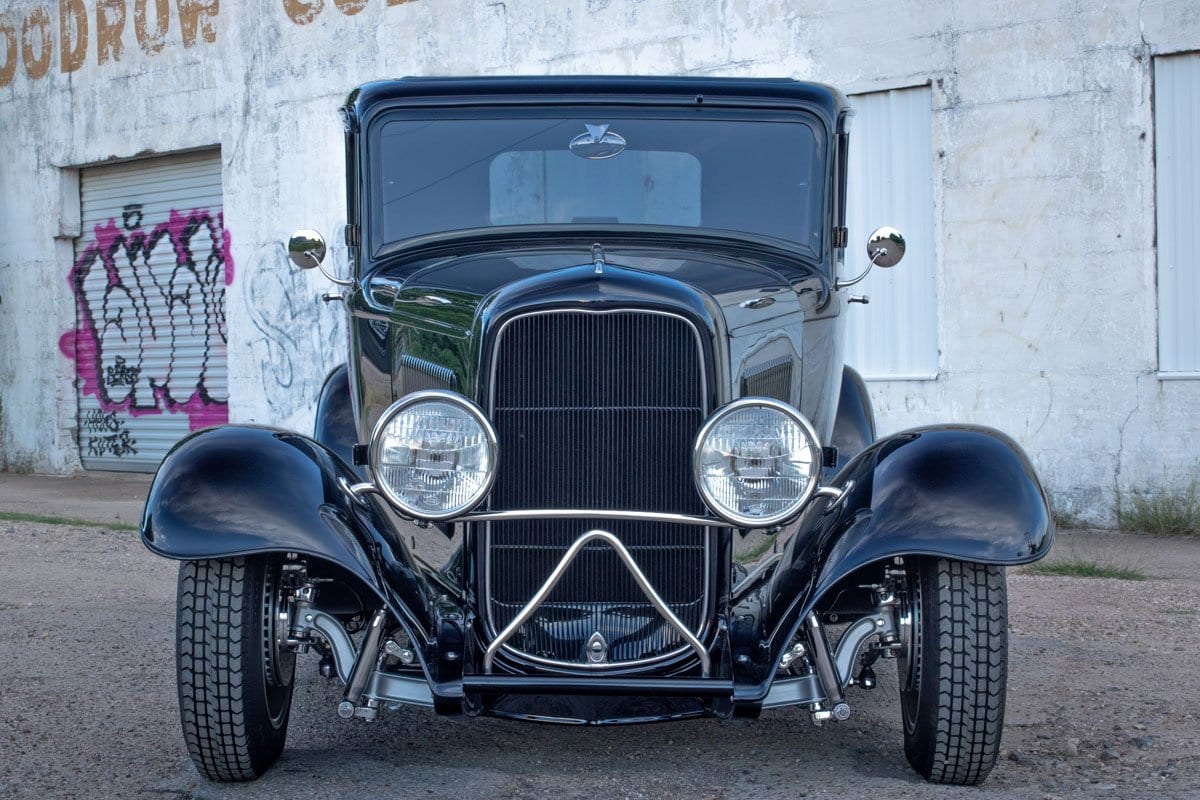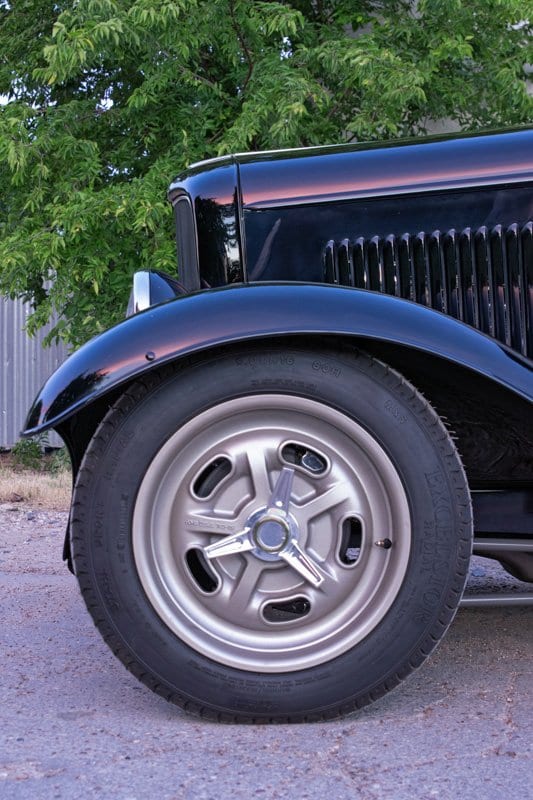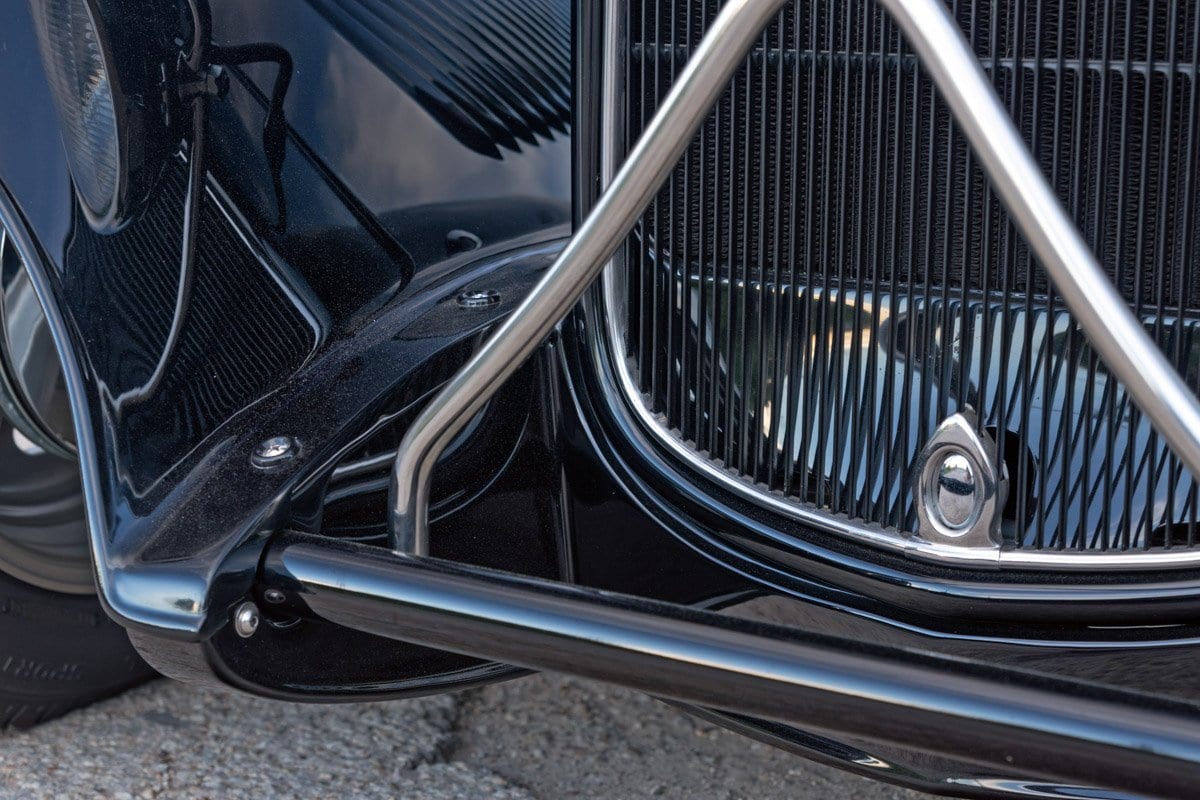Texas Tradition – George Jezek Extends His Streak of Clean Street Rods With this Slick Black Deuce
Countless versions of the traditional black Deuce have been built through the decades. Pairing the quintessential street rod with Henry’s favorite color is a timeless template, yet even with a good set of plans and great historic examples from which to draw inspiration, some versions still tend to fall flat. Like any good creation, it’s the care of craftsmanship and attention to detail that separate the best from the rest.
George Jezek’s Deuce five-window coupe is a good example of a classic black Deuce that hits its mark using quality craftsmanship and great detail. George has the benefit of more than 60 years of hot rodding experience, dating back to his first ride – a ’46 Chevy pickup built when he was just 14. He followed that up with a ’49 Chevy custom while he was still in high school that made it into the pages of several ’50s “little pages” magazines. His career as an architect honed his natural knack for detail and precision and he’s applied that to a long list of cool rides that followed, including multiple Model As, ’40s and ’50s Chevys, Corvettes, and muscle cars.

“I usually build a car and then play with it for a couple of years and then sell it,” George says. “I enjoy the building as much as I do the having, so to speak.”
Like many rodders, George has a thing for ’32 Fords and has built a number of nice ones through the years. Two relatively recent examples include a maroon roadster that garnered a number of awards and accolades five or six years ago, and a black sedan that graced the pages of The Rodder’s Journal issue 15 back in the early-2000s. This coupe is similar in style to that sedan.

George says he’s always preferred the five-window coupe to the three-window versions and was fortunate to find this one within 100 miles of his home in Waco, Texas. The car was largely original, with a warmed-over Flathead and a relatively solid body. He ultimately decided to sell the chassis and drivetrain to a friend and start fresh with a new foundation.

Pete & Jake’s handled the fabrication of the new frame, which was built with a Chassis Engineering X-member (“I just like the traditional look that it gives you,” George says). The Front suspension was completed using an aluminum Super Bell dropped axle on a Posie’s spring, Wilwood disc brakes, and hairpin radius rods. Out back, a ladder bar setup with coil-overs located and suspended the 4.11:1-geared John’s Industries 9-inch rearend. George used powdercoat to detail most of the suspension parts and Jet Hot coating on the exhaust, with the exception of the polished stainless Flowmaster mufflers. The 16×5.5- and 16×6-inch So-Cal knock-off wheels were powdercoated to look like magnesium before being wrapped in Excelsior tires.


George turned to Texas engine specialists Smeding Performance for the 383c.i. stroker small-block Chevy engine. Four-bolt mains, a forged rotating assembly, aluminum heads, and a roller camshaft were part of the package, with a trio of Holley carbs on top providing a bit of classic hot rod flavor. Sanderson block-hugger headers were Jet Hot coated to match the exhaust, while the finned aluminum Corvette valve covers were coated to match. The engine is backed with a Tremec five-speed transmission from Bowler Performance.

Subtle modifications and finesse help distinguish the unchopped Deuce body. George extended the front fender beaded edges down to blend with the modified frame horn covers and peaked the grille shell, topping it with a custom stainless bullnose. He also narrowed and lowered the headlight bar, modified a stainless ’34 Ford accessory grille guard to fit, and replaced the stock-style hood side hold downs with push-button latches. Around back, he built a custom spreader bar to match the curved sculpture of the fuel tank, made custom brackets to mount ’37 Ford taillights, and crafted a custom license surround and trunk lock plate and cover.

When all the metalwork and bodywork was complete, George had Car Connection in West, Texas, apply the beautiful black finish using BASF single-stage gloss black, which was topped with gloss clear for extra depth. He tells us that his hot rods have historically had red frames and chassis components, and while the frame on this one is black, he kept the tradition alive by painting the bottom of the body red. “I like to have a surprise for whoever chooses to get on their knees and look underneath,” George says.

The inside is as sanitary as you’d expect. The lower dash lip was modified to fit the contour of the ’50s-era Stewart-Warner gauge panel, which is filled with Classic Instruments dials. George also reshaped and painted the billet aluminum column drop to give it a more vintage style, filling it with an IDIDIT column and a Juliano’s wheel topped with a custom-cast resin horn button made from a mold taken off a ’38 Ford.

The bench seat started out as the third-row seat in a Dodge Caravan. “Those seats work pretty good,” George says. “I narrowed it 6-inches and raised the back up. It hinges, so you can fold the back forward and have access behind the seat.” Gabriel & Son Upholstery gets credit for the skillful trimming and stitching of the brown leather on the seat, door, and side panels, as well as the completely upholstered trunk.
It’s not really surprising that this Deuce came out so clean, considering all the practice George has had through the years. “All of my cars have always been very traditional with very subtle nuances,” George says. “I like to have something somebody can look at and not really see everything until they walk around it two or three times.”

The combination of classic style, carefully selected aftermarket components, and well-considered details is something George likes to call “newstalgic.” It’s street rod build theory that tends to result in clean cars that age well, and we’re happy that rodders like George Jezek have been upholding the tradition for so long and setting a good example for others to follow.
Photos by Darrell Vickers













